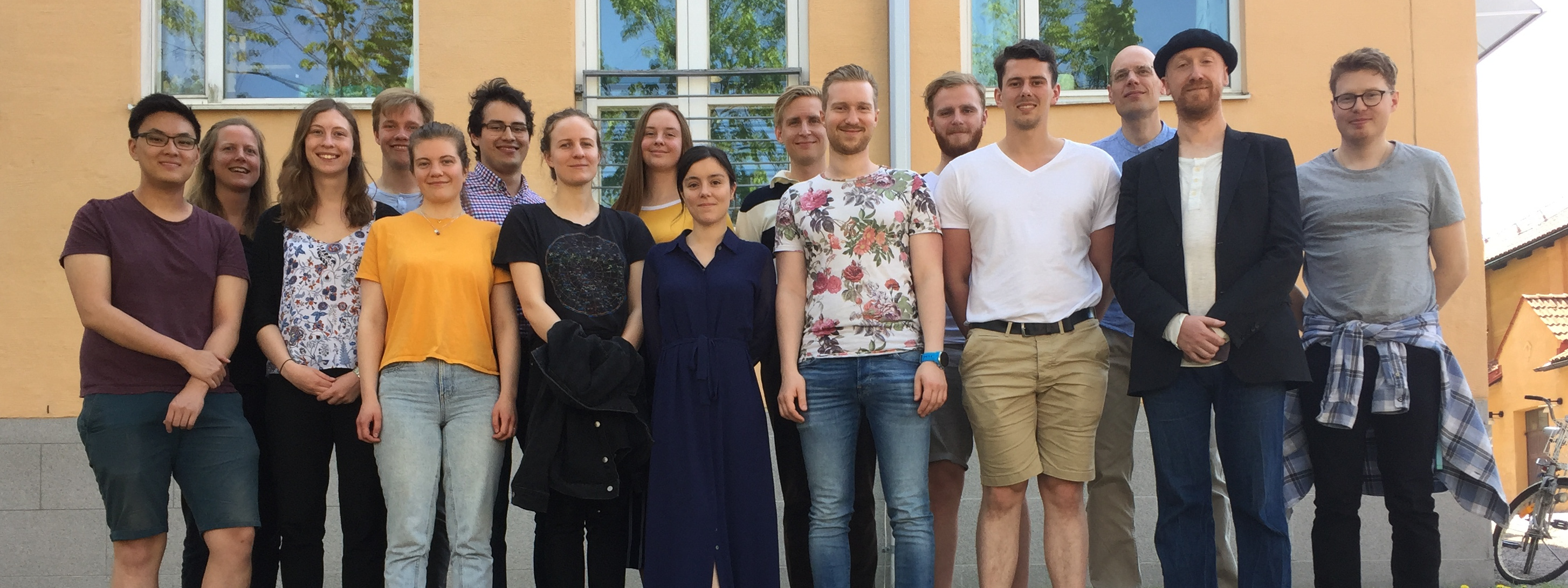Nu är programmet för Almedalen ute, och vi kommer att dyka upp i diskussioner kring den Digitala Tvillingen på måndag den 5 juli kl 13.15-14.00. Missa inte! Konferensen är digital så du kan se den bekvämt hemifrån soffan.
Programmer wanted!
Uncategorised Posted on Tue, May 25, 2021 11:30:31We are looking for a programmer to work on the interface for the digital twin project. Please spread to anyone you think would be a good match!
Here is a short film about the Digital Twin project.
Our work with the new digital twin technology – an interactive computer model, describing the multi-organ, and multi-timescale biochemistry and physiology of a specific person – has now led to a first prototype which is almost ready to be tested in a clinical environment. However, to be able to do that, we need to have suitable user interface, and this is where you come in!
In english:
“We are looking for someone experienced in working with programming, visualisation, software architecture, and user friendliness. Submitting a sample of previous work with you application will increase your chances, in particular apps and software projects that includes visualisation. You are interested in design and you are an attentive listener who can work in a group setting to interpret the best solution to what researchers, clinical personnel and private users need.
Your tasks will primarily be development of the front-end software for research and clinical environments, focusing on visualisation and app-design. ISB group at IMT have developed a so called Digital Twin, computer model copies of a patient, which will function as support for the Health Conversation. We have a few previously developed prototypes, but now we need someone to help us make a version with a user interface suitable for testing in clinical studies. You will work mostly with the coding of the software, but some design and user interaction and evaluation is also included.”
På svenska:
“Vi söker nu någon som har erfarenhet av att arbeta med programmering, visualisering, mjukvaruarkitetktur och användarvänlighet. Tidigare arbetsprov av egna utvecklade appar och andra mjukvaruprojekt, speciellt sådana som inkluderar en visualiseringskomponent, är en viktig del av bedömningen. Du är antagligen intresserad av design och en god lyssnare som kan arbeta i grupp och tolka vad både forskare, vårdpersonal och privata användare behöver.
Dina arbetsuppgifter kommer bestå i framför allt arbete med att utveckla front-end mjukvara för en vetenskaplig och klinisk miljö, med fokus på visualisering och app-design. I ISB-group på IMT har vi utvecklat en så kallad Digital Tvilling, datorkopior av en patient, som ska fungera som stöd i vårdens hälsosamtal. Vi har tidigare utvecklat ett par prototyper, men behöver nu någon som gör en första mer färdig version av användargränssnittet att testa i kliniska studier. Du kommer att arbeta mycket med själva kodningen av mjukvaran, men en del design och användarinteraktion ingår också. “
If you have any questions, please contact Karin Lundengård at karin.lundengard@liu.se
- Comments(0) https://blog.isbgroup.eu/?p=196
Invited lecture (and possibly teaser-performance) in upcoming MBM workshop
Events, News Posted on Thu, September 10, 2020 00:57:45There are quite a few public lectures planned for this autumn, and one of the ones I am looking forward to a little bit extra is the MBM workshop, in Gothenburg, on October 15-16, 2020. MBM stands for Modelling in Biology and Medicine, and this is the second edition of the workshop. The workshop started as an initiative by a couple of enthusiastic Ph.D. students at the Math Department at Chalmers/Gothenburg University. But since it turned out so successful, they easily got both the support by the more senior leadership at the department, and enough positive feedback to decide to do a second edition. I really liked attending it last year, both since it was a Swedish workshop on systems biology, which means that it helps foster and grow the Swedish systems biology community, and since they managed to create a nice and cosy athmosphere. Partially because of this, the post-conference informal conversations last year led to me mentioning some of the bigger plans I am working on, which are going to become more public this year.
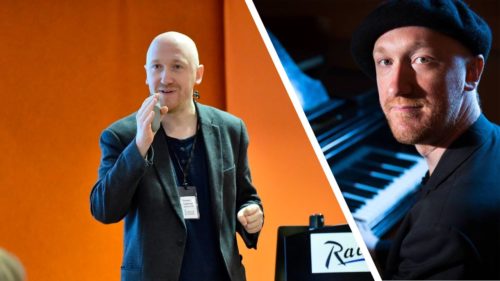
Those plans involve me combining my science and create careers into one, by doing joint lecture-performances, mixing piano, dancing, and digital twin-based stories. The original plan for this year’s workshop was to do some version of such a lecture-performance at the physical workshop. But since the physical edition had to be cancelled – due to the pandemic – the lecture will be held online. Nevertheless, in the presentation text of me at the home page, my CV covers – for the first time in a scientific event! – both my science and creative careers are mentioned side by side, and as two parts of the same thing. Already this feels really cool! And during the lecture, I plan to say, and probably also show, something short about those new and border-crossing plans in action. The workshop is held completely online, so you will be able to see it, also if you are not living in Sweden. And, later in the autumn, a more proper trailer for the first such lecture-performance will be released. The first proper such lecture-performance is planned be held during the autumn of 2021.
An exciting autumn awaits! And, the workshop is still open for abstract submissions!
- Comments(0) https://blog.isbgroup.eu/?p=183
New grant: 2 MSEK from ELLIIT “Usable digital twins in healthcare”
News Posted on Tue, September 08, 2020 00:28:07We have gotten a new grant! The money this time comes from ELLIIT, which is a joint technology programme for Linköping, Lund, Halmstad University, and Blekinge Institute of Technology. The project we applied for is called “Usable digital twins in healthcare“, and it will focus on solving the many different practical challenges involved in bringing our digital twins into actual clinical practice: involving e.g. legal, technical, and ethical issues. A summary of the project and its main steps is given in the figure below. The funding is 2 MSEK, i.e. 200 kEUR/kUSD over a two-year period.

- Comments(0) https://blog.isbgroup.eu/?p=180
Upcoming lecture in new European webinar series on 3R, Sept 22-24
3R and animal experiments, Events, News Posted on Sun, September 06, 2020 22:56:51A new international webinar series on 3R – replacement, reduction, and refinement of animal experiments – is about to start! And we are present with a lecture!
From our group, Gunnar Cedersund and Elin Nyman are members of the National Committee on 3Rs, which also serves as the steering committee for the Swedish 3R center (S3RC). Our S3RC has now joined forces with a few other corresponding national centres, and this has led to the launch of a new webinar series. The first edition of this will take place on Sept 22-24, lunch times i.e. 12.30-13.30 CET. Gunnar will present a lecture on digital twins on the last day, i.e. Sept 24.
This is a great initiative, and I hope it will be the start of more collaborations between the centres!
More info, and sign-up here.
- Comments(0) https://blog.isbgroup.eu/?p=170
Upcoming Ph.D. defense, Sebastian Sten, “Mathematical modelling of neurovascular coupling”
Events, News Posted on Sat, September 05, 2020 01:59:22https://www.youtube.com/watch?v=OTvhkYVhq5Y&feature=youtu.be
On Friday, this coming week, September 11, 2020, at 9AM CET, our Ph.D. student Sebastian Sten will defend his Ph.D. thesis, entitled “Mathematical modelling of neurovascular coupling”.
Sebastian has been co-supervised between Gunnar Cedersund (who leads this group), Fredrik Elinder (BKV and electrophysiological expert), and Maria Engström (who was the main supervisor, and who is an expert on fMRI). In the thesis, Sebastian presents four papers which incrementally unravels more and more mechanistic details of how the main signal in fMRI – the BOLD signal – is generated. In Paper 1, he demonstrates that the main part of the BOLD signal response can not be caused by a negative feedback, as was first believed, but by a combination of a fast positive and a slow negative feedforward arm. In Paper 2, the model from paper 1 is extended with GABA, which makes it able to describe the negative BOLD response. In Paper 3, he unravels more mechanistic details of the two arms, and finds out that there are in fact at least three arms: the fastest positive is the NO-arm from interneurons, the slightly slower positive arm is the PGE2 arm from pyramidal cells, and the slowest negative arm is caused by NPY interneurons. In the final paper 4 (still in ms), these mechanistic details for the signalling and the control of the arteriolar diameter is embedded in a larger model, which also contains the biomechanical flow to capillariies and venules, and the creation of the actual BOLD signal. The final model is – to the best of our knowledge – the most complete and comprehensive model for the BOLD signal, and it simultaneously describes data and extracts information from informative optogenetic stimulation experiments in mice, from unique BOLD and Local Field Potential (LFP) experiments in monkeys, and from advanced MRI measurements of BOLD, volumes and flows, in humans.
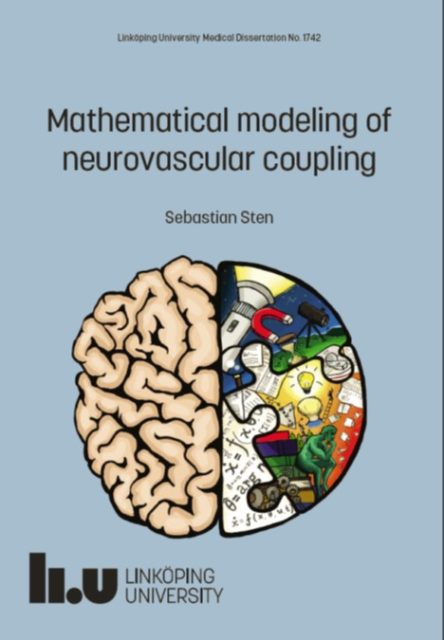
Front page of the thesis, illustration done by our other group member Christian Simonsson, who wanted to capture not only the brain, but that experiments, analysis, and mathematical modelling has come together.
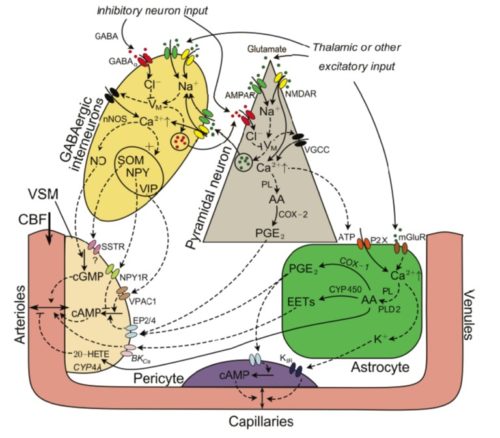
Overview of the main processes studied in the thesis.
After the defense, Sebastian will work for two more weeks, wrapping up the final paper. Thereafter, other people in the group will continue to work on these models, e.g. by connecting them to more detailed models for metabolism, electrophysiology, and – eventually – to clinical practice, e.g. by allowing for more measurements to come together into a more comprehensive and complete analysis of fMRI data. However, Sebastian himself will thereafter start a position at AstraZeneca, in the group we have the most contact with there: their metabolic and cardiovascular preclinical modelling group.
A link to the Ph.D. thesis is found here, and a link to the youtube event where the defense is broadcasted is found here.
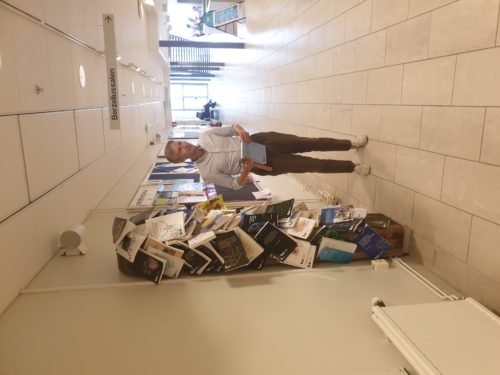
Sebastian about to do the final formal step before the actual defense: nailing his thesis to the “thesis tree” of the medical faculty.
- Comments(1) https://blog.isbgroup.eu/?p=160
Presentations at the VPH Virtual Physiological Human conference
3R and animal experiments, Events, News Posted on Sun, August 30, 2020 01:43:23As usual, we have attended the Virtual Physiological Human conference, which this year was given as an eConference. This year, our group was represented with two oral presentations, and three poster presentations. The first oral presentation was held by Gunnar Cedersund, with the title: “Multi-organ and multi-level digital twin models enters the clinic”, and it was similar to the presentation already held at numerous earlier occasions, e.g. at Almedalen, in the Swedish Parliament, at NIH, etc.

The second presentation was of a new project: Belén Casas’ postdoc project on modelling of microphysiological systems. This project is financed by AstraZeneca, who are the ones who do the experiments, in collaboration with the company TissUse. This modelling has allowed us to both understand the available system better, and to create a first translation up to humans. This brings us one step closer to finding a workable replacement for animal experiments regarding research on type 2 diabetes and Nonalcoholic SteatoHepatitis (NASH) in the liver. The postdoc project has been supervised by Gunnar Cedersund and Peter Gennemark (AstraZeneca, but also adjoint associate professor in our group). Since Belen is now away on parental leave, Peter gave the presentation. The three final poster presentations were on digital twins and multi-level modelling (Tilda Herrgårdh), on modelling of fatty acid fluxes in the fat tissue (Kajsa Tunedal), and on a new model for exercise (Antonia Klingsäter). Apart from our own presentations, it was interesting to see that the new ASME V&V40 guidelines from FDA, on usage of modelling in certification, are getting more and more traction. Another interesting presentation was the keynote held by Tarique Hussain, who talked about how he has been using advanced modelling of the heart, to help guide treatment planning of complicated cases in child cardiology.

- Comments(0) https://blog.isbgroup.eu/?p=164
New postdoc position in the new 12 MEuro X-HiDE project
Uncategorised Posted on Sun, August 30, 2020 01:17:35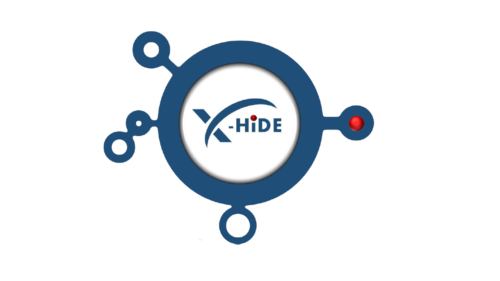
There is a now a first postdoc position open in the new X-HiDE project, of which we are a central part. X-HiDE is a new major systems biology center that is about to launch in Sweden, which recently got a major grant of 12 MEuro, over an 8 year period. The topic will be systems biology of immunology. The over-arching goal is to build up a comprehensive and re-usable model, to be useful as a module in other models for a wide variety of diseases associated with dysfunctional inflammation: cardiovascular disease, auto-immune diseases, NASH, COPD, diabetes, cancer, etc. There are more than 10 experimental and clinical partners on board, which all will contribute with data and biological/medical expertise. Apart from this, a number of large and small companies are on board as co-funders, including e.g. AstraZeneca, and Wolfram MathCore. This particular postdoc is focused on modelling, and the main expertise sought after is data-driven mechanistic modelling (typically done using ODEs).
Because of the existence of the long-term substantial funding, there will be more similar modelling positions opened up later, including a soon to be announced more senior tenure-track position. These early positions will be excellent opportunities for junior researchers, who want to be a part of building up a new systems biology center.
NOTE: Deadline for this first postdoc position is midnight September 1 CEST!
/Gunnar Cedersund, leader of X-HiDE’s workpackage on modelling
- Comments(0) https://blog.isbgroup.eu/?p=158
